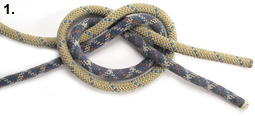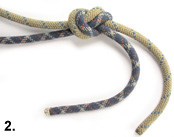Sponsored By
ROCK
HARDWARE
Joining Two Ropes
This is a touchy subject. Opinions vary among climbers as to the best knot to use when joining two ropes together. The figure eight, overhand, & double fishersman's are just three methods. There's many reasons why you'd want to join two ropes together, but perhaps the most obvious one is to allow for a full rope length retrievable abseil.
Rethreaded Figure Eight ![]()
There is more than one way of joining two ropes using a figure eight knot.
The method described below is purely the one I prefer. One disadvantage of
this method is that it leaves a bulky profile to the knot which could well get stuck when
you pull the abseil ropes down. If speed and stuck ropes is a concern, perhaps investigate the
double
fisherman's
method or the overhand knot (see below). The
advantage of the figure eight with stopper knots over the double
fisherman's is that it's often easier to untie afterwards, plus what I'd
call a psychological advantage. Anyway, follow these steps to join two ropes with
a figure eight knot:
Step 1: Put a figure eight in the end of one rope. Step 2 & 3:
Rethread the
eight with the end of the other rope. Leave plenty of tail (probably more
than pictured), because the
knot will slip a bit as it is tightened.
Step 4: Because I'm paranoid
about the figure eight slipping I generally add a stopper knot
to each end
as well. The figure eight with stopper knots is my preferred method,
however as I say, opinions vary.
Note: Avoid using the "Abnormal Figure Eight" (pictured left), which Bush Walkers Wilderness Rescue's research shows to be dangerous. They state: "The Abnormal Figure 8 Knot is dangerous due to roll back slippage. It is possible that this knot when poorly packed and with short tails could completely undo with loads as low as 50kgs". See Also: Abseil Knots on Needle Sports, and this accident report on rec.climbing or R&I, in which such a knot may have killed a climber.
Double Fisherman's ![]()
Here's another way to join two ropes, the double fisherman's (pictured
below). This method results in a smaller profile knot (should give less
chance of stuck ropes) than the aforementioned figure eight method. Its
basically just two stopper knots. Follow these steps:
Step 1: Put a stopper knot in the end of
one rope. The trick with stopper knots is to form two loops, the second
behind the first, and feed the tail back through both. Step 2:
Before you tighten the knot, pass the end of the other rope through both
loops as shown.
Step 3: Now form another stopper knot, this time with the
second rope, wrapping your loops around the first line.
Steps 4 & 5: Tighten both knots and draw them snug against
each other. Leave plenty of tail (probably more than pictured), to account
for any slippage.
It's hard to describe in words. Be very sure you've got it right before abseiling down. I strongly suggest you get someone experienced to teach you this knot, in person, so they can verify you've got it right. The consequences of a mistake, when using this knot to join two ropes for abseil, are naturally going to be very serious indeed. Furthermore, its easy to stuff this up, especially if its cold, dark and wet and you're looking to bail in a hurry, so perhaps this is not the best method to employ, though it certainly works if done correctly. The knot can also be difficult to undo once you've weighted it.
Above Right: The double fisherman's used to join the ends of some accessory cord to form a loop, suitable for friction knots such as the Prusik, etc.
Overhand Knot
![]()
The
overhand knot is probably the simplest and fastest knot you can form to
join two ropes together for abseil. This can be very handy in situations
where speed is critical to safety. It's also generally believed to be the
least likely knot to get stuck when the ropes are pulled. But how scary
does it look? Even with the recommended super long tails, the knot can take some
getting used to.
The theory with this knot is that it will slide flat against the rock and flip over an edge rather than jamming. (See picture right, and check out Petzl's page explaining the concept).
Follow
these steps to form an overhand knot to join two ropes:


Step 1: Grab an end of each rope and form the simple pass shown
above. Step 2: Pull tight, leaving a large amount of tail (ie.
about a metre) for both ends, to account
for any slippage. It shouldn't slip too greatly if the ropes are of the same
diameter, but this is not something to skimp on. You should probably leave
more tail than the pictures above imply.
Note comments such as "The Overhand Knot should not be used on tape due to progressive cyclic slippage." and "There may be an issue with the strength of the Overhand Knot when used on older rope.", appear in research articles from the Bush Walkers Wilderness Rescue.
Reader's Feedback ![]()
From Kieran Loughran:
1. If you are doing a multi-abseil retreat using two ropes of equal diameter
then the overhand knot is more secure than an figure-8
2. Use a double-fisherman knot to join ropes of unequal diameter for
multi-abseil descents.
3. If you are using two ropes as a fixed line, first join them with a
double-fisherman knot and then tie an alpine butterfly knot that
incorporates the double-fisherman knot in the loop. That gives you three
things 1. A bomb-proof knot; 2. A built-in safety loop to clip on the knot
changeover; 3. Knots that are easy to untie (unless you had to weight the
safety loop, in which case you won't care).
Further Reading:
Preferred Knots For Use In
Canyons - Documents actual testing of Tape, Double Fisherman's,
Overhand for rope and tape, Rethreaded Figure 8, Abnormal Figure 8 and
Alpine Butterfly from Bush Walkers Wilderness Rescue web site.
Abseil
Knots - Further testing and warnings against the abnormal figure eight
knot on Needle Sports site.
Double Fisherman's
- From University of New England Mountaineering Club.
Overhand knot
- From Petzl's web site.
Figure Eight With A Loop - Also from Petzl's web site.
Dawn's
FAQ - For rec.climbing discussions and arguments about the best knot to
use when joining two ropes for an abseil.
How
To Deal With Stuck Ropes - From Climbing Magazines Tech Tips.
Rope And Gear
Testing - Results of pull tests on various knots joining different
ropes.
EDELRID Knot Tests
- Results of testing double fisherman's, and EDK, etc. Unfortunately much
of the text is in German.
Home | Guide | Gallery | Tech Tips | Articles | Reviews | Dictionary | Forum | Links | About | Search
Chockstone Photography | Landscape Photography Australia | Australian Landscape Photography
Please read the full disclaimer before using any information contained on these pages.
All text, images and video on this site are copyright. Unauthorised use is strictly prohibited.
No claim is made about the suitability of the information on this site, for any purpose, either stated or implied. By reading the information on this site, you accept full responsibility for it's use, and any consequences of that use.
